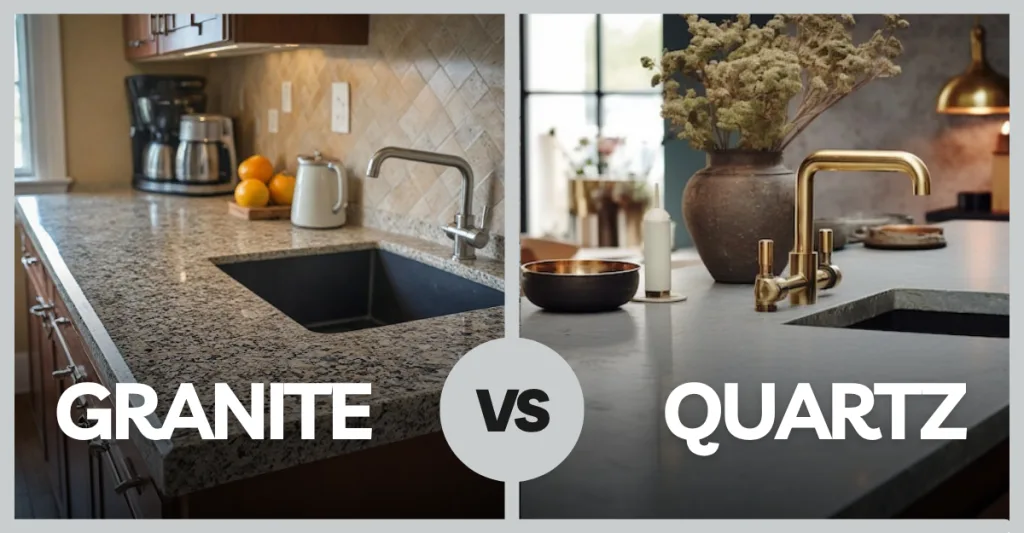Homeowners and designers pick countertops that must look great and survive real use: spills, hot pans, heavy cookware, and daily traffic. In the last decade engineered quartz rose fast while new safety and environmental research (and national policy changes) have changed how professionals and consumers evaluate both options. This guide walks through the facts, compares performance, and gives practical buying guidance backed by primary sources.
How they’re made: raw materials and manufacturing
Granite (natural stone). Granite is an igneous rock composed mainly of quartz, feldspar and mica; its hardness generally falls around 6–7 on the Mohs scale because of those minerals. Granite slabs are quarried, cut into slabs, and polished for countertops.
Engineered quartz (often called “quartz” or “engineered stone”). Engineered quartz countertops are manufactured products made largely from crushed natural quartz (typically ~85–95% by weight) mixed with polymer resins and pigments, then compressed and cured into slabs. Because they are factory-produced, quartz slabs offer more uniform color and patterns and can include colors not found in nature. Manufacturer technical data and spec sheets describe typical composition and manufacturing processes.
Durability: heat, scratch, stain, and impact
Hardness and scratch resistance
Quartz (the mineral) rates about 7 on Mohs; feldspars (major granite components) are about 6–6.5 — so both materials are hard and resistant to everyday scratching. In practice the engineered slab’s mix of quartz fragments and resin makes it highly scratch-resistant; natural granite resists abrasion as well but varies by slab.
Heat resistance
Natural granite is formed under immense heat and is broadly more tolerant of hot pans and sudden temperature spikes than resin-based engineered quartz. Manufacturer guidance for quartz brands (Caesarstone, Cambria) repeatedly warns that direct, sustained contact with very hot cookware may scorch, discolor, or delaminate the resin binder — manufacturers therefore recommend trivets or hot pads. In short: granite tolerates heat better; quartz tolerates everyday warmth but not prolonged direct contact with very hot cookware.
Stain resistance and porosity
Quartz slabs are effectively non-porous because of the resin binder and do not require sealing; they resist most food and beverage stains and microbial ingress when cared for with recommended cleaners. Granite is naturally porous to varying degrees and is usually sealed at installation; sealing reduces staining risk but must be maintained periodically, with recommended reseal intervals varying by stone and sealer quality. Consumer testing and trade guidance back these distinctions.
Impact, chipping, and repairability
Both materials are heavy and strong. Granite can chip at edges but can often be repaired invisibly with epoxy; engineered quartz can chip or crack, and repairs are possible but sometimes visible because color/pattern uniformity is different from the natural stone match. Manufacturer warranty terms vary.
Health & safety: what consumers should know (fabrication risk vs in-home safety)
In-home use: Finished granite and finished engineered quartz countertops are safe for ordinary household use. Neither emits hazardous gases in normal conditions; both are safe under standard residential conditions when installed by professionals. Manufacturer care guides advise routine cleaning and to avoid harsh chemicals.
Workplace hazards during fabrication: Cutting, grinding and polishing engineered quartz (which can contain >90% crystalline silica) generates respirable crystalline silica dust. High exposures have been linked to rapidly progressive silicosis and other serious respiratory disease in fabricators worldwide. Public-health agencies (NIOSH/CDC, OSHA), peer-reviewed case series, and national responses (including a landmark engineered-stone ban in Australia) document this occupational hazard and the need for strict dust controls, wet cutting, ventilation, and medical surveillance. This is a worker-safety issue — it does not imply finished slabs in kitchens are unsafe, but it does mean purchasers should ask fabricators about safety practices, training, and whether the shop follows respirable-silica controls.
Maintenance & care: what daily life looks like
Quartz (engineered): No sealing required; daily cleaning is simple — mild soap and water or manufacturer-recommended cleaners. Avoid abrasive pads and strong cleaners (bleach, oven cleaner, concentrated alkalis/acid). Use trivets for very hot items; promptly clean spills of strongly pigmented or caustic substances. Manufacturer care pages and technical manuals give specific do-and-don’t lists.
Granite (natural): Typically sealed at installation; reseal frequency depends on stone porosity and usage (common guidance: test periodically and reseal every 1–10 years depending on product and wear). Clean with pH-neutral stone cleaner; avoid acidic cleaners on calcareous stones (marble not granite). If a stain occurs, there are proven poultice and professional restoration techniques.
Environmental footprint & sustainability
Life-cycle assessments (LCA) and Environmental Product Declarations (EPDs) show no simple winner: impacts depend on raw material, manufacturing energy, distance transported, slab yield (how many usable square feet come from a block), and resin content. Natural stone’s extraction and long-distance shipping can create significant transport emissions; engineered quartz uses fossil-based resins and manufacturing energy but can incorporate stone byproducts. Independent LCAs and trade association reports highlight that the cradle-to-grave footprint varies by brand and supply chain — buyers who prioritize low impact should request EPDs or LCA summaries from suppliers and compare on a per-square-foot, cradle-to-installation basis.
Cost, resale, and market trends
Typical installed cost ranges (U.S. market snapshots): Quartz and granite prices overlap heavily. Recent home-improvement cost guides show broad ranges (roughly $50–$200 per sq. ft. installed depending on brand, slab grade, and complexity); local market, edge profile, cutouts, and labor strongly influence final price. For a reliable estimate, get written quotes that specify slab grade and installation details.
Resale and popularity: Industry reporting and renovation-market surveys indicate engineered quartz has grown in popularity in the 2010s and 2020s; many designers choose quartz for predictable coloration and low maintenance, while buyers seeking unique, natural surfaces still favor granite. Local resale effects depend on buyer expectations in your market.
Choosing for your kitchen: scenarios and recommendations
If you want a “no-fuss” daily life: Choose engineered quartz for its non-porous surface and minimal routine maintenance; ideal for busy families or households that want consistent color across multiple slabs.
If you cook with high heat and put hot pans on counters often: Favor granite (and still use trivets). Granite tolerates heat and thermal shock better than resin-binders; porcelain is also an alternative for extreme heat resistance.
If worker safety and supply-chain impacts matter to you: Ask your fabricator about their silica-control practices, medical surveillance for staff, and whether the slabs were cut in shops following OSHA/NIOSH or local reliable standards. If you want to avoid the engineered-stone fabrication chain entirely, select natural stone or low-silica alternatives (porcelain, solid surfaces) that don’t involve high-silica dust during fabrication.
If you want unique natural patterns and one-of-a-kind stone: Granite provides natural variation and “dramatic” veining that engineered quartz often replicates but cannot fully duplicate.
Practical buying checklist (quick)
- Ask for slab photos of the actual slab(s) to be installed (not catalog shots).
- Request the manufacturer spec sheet, warranty, and EPD/ LCA summary if sustainability matters.
- Confirm whether the fabricator uses wet cutting, local exhaust ventilation, and PPE — and ask for records or a statement on silica controls.
- Get at least three written quotes that break out material, fabrication, seams, cutouts, and installation.
- Plan for accessories (trivets, cutting boards) even with robust surfaces — they extend the life and keep finishes flawless.
Conclusion
Granite and engineered quartz are both excellent choices; the “best” depends on how you prioritize maintenance, heat tolerance, appearance, environmental concerns, and worker safety. Granite wins on natural heat tolerance and one-of-a-kind aesthetics; engineered quartz wins on low maintenance, stain resistance, and color control — but engineered-stone fabrication requires rigorous dust controls for worker safety.
About BBV Impex
BBV Impex is a leading marble and granite exporter & supplier known for its honesty, consistency, and deep understanding of natural stones. We source our materials directly from trusted quarries and deliver carefully processed slabs and blocks to clients worldwide. Our team believes in long-term relationships built on trust, quality, and commitment. From classic marbles to durable granites, every stone we supply carries the mark of fine craftsmanship and natural beauty. At BBV Impex, we don’t just trade stones — we help builders, architects, and homeowners bring their design ideas to life.

